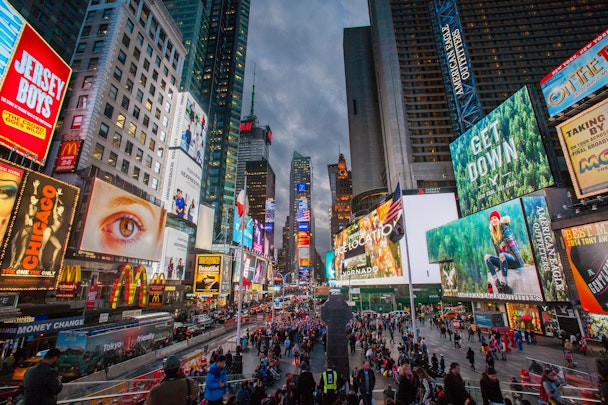How many ads do we really see in a day? Spoiler: it’s not 10,000
Hundreds of articles and blogs will tell you that we see up to 10,000 ads a day. The problem? No one – from Harvard professors to Market Research Council hall-of-famers – believes it’s true. Can we bust the myth once and for all? It's time for an experiment.

How many ads do we see a day? The number you've heard is probably wrong / James Ting via Unsplash
If you ask Google how many ads the average person sees in a day, it’ll give you an array of half-answers, many of them clustered around three figures: 3,000, 5,000 and 10,000.
Are those numbers accurate? Step one in finding out would be to track the numbers back to their sources. But that isn’t easy. In fact, it’s impossible, because they’re not numbers that any researcher ever alighted on with any conviction.
The Drum’s quest to locate these stats’ source led us to a raft of professors and decorated researchers, all of whom say that (like little else in the history of advertising, we’re sure) it’s a load of nonsense.
The source of the stat
Go and Google ‘how many ads do we see a day?’ The first few pages of results is a self-referential web of blogs, optimized much better for Google than for answering your question. Ironically for a story about clutter and information overload, a deluge of content marketing drowns out any serious attempt to answer the question.
It’s possible to trace these stats to a trio of stories in reputable publications: the CBS Morning Show in 2005 and 2006, then The New York Times in 2007. So those 3,000-5,000 figures are at least 15 years old, from a time when, per the NYT piece, digital billboards were “the next big thing”.
All three cite as their primary source of the 5,000 number American researcher J Walker Smith and a book he co-authored, 2005’s Coming to Concurrence. Smith is now knowledge lead for Kantar’s consulting division (and a Market Research Council hall of famer); back then, he was president at the Yankelovich research firm (which became Kantar Futures).
But Smith tells The Drum he’s never said or thought that we see 5,000 ads a day. “Our intention was not to endorse any particular number,” says Smith, “only to say that marketers and those who study marketing are concerned about growing ad clutter”.
That book was focused on what it called “the biggest problem facing marketing and marketers”: “marketing productivity, and the consumer resistance that is creating this problem”. He was not particularly interested in quantifying ad exposures (for reasons methodological and sociological, he says, “I don't believe an exact number is possible”), but in showing that “poorly targeted marketing means ever more advertising, and the resulting, increasing ad clutter was causing consumer attitudes about and receptiveness toward advertising to plummet” leading to “more inefficiency and thus increasing costs”.
In 2007, the spreading 5,000 figure prompted the American Association of Advertising Agencies (4A’s) to release a short document debunking it via a history of ad exposure research since the 50s. That pamphlet concluded that “These numbers are unsubstantiated, and the citations never get more specific than ‘experts agree‘...” and that “the wildly high estimates of ad exposure are overblown”.
“Yes, that 5,000 figure went viral from me,” says Smith. “But I agree with the 4A’s”.
Advertisement
The professor and the student
Unbelievably, the 5,000 figure goes back far further than Smith’s 2005 book – to the Nixon administration. Smith referenced a history of research that gives numbers “as high as 5,000 ads a day”, pointing back to a 1968 book by two Harvard business professors, Raymond A Bauer and Stephen Greyser, called Advertising in America: The Consumer View.
Greyser, now 88, is still a professor at Harvard Business School. In a storied career, Greyser has been profiled by Marquis Who’s Who; and had a successful sideline as a sports broadcaster on Harvard’s WHRB radio.
Like Smith, Greyser thinks that estimates in the thousands are nonsense: “If you take the mythic 1,500 ads a day – if one unpeels that, one comes away and goes, ‘hey! That’s bogus!’”
Bauer and Greyser’s book referenced numbers in the thousands, he says, only as “conversational items” that have taken on “a mythic character”. For example, the 1,500 number came, they say, from researcher Edwin Ebel’s attempt to estimate the total ad exposure of a family of four by multiplying standard media consumption by average ad inclusion per channel.
Advertisement
Working alongside legendary (and controversial – his work on counterinsurgency during the Vietnam war saw him branded a “war criminal” by protesters, but that’s a story for another day) social scientist Ithiel de Sola Pool and pioneering Harvard mathematician Frederick Mothsteller, Bauer and Greyser conducted research to disprove that number: 750 people were asked to manually count their ad exposures across four media (magazines, newspapers, radio and television). The result was an average of 76 exposures per day.
In 2007, a master’s student at the University of Nebraska Omaha, Mark Blackwell, recreated Bauer and Greyser’s methodology, coming up with an updated figure of 98.5 ads per day on average – an increase of 22.5 since 1968, not thousands.
These results have largely been lost to time. A number in the thousands has perhaps simply felt truer to writers over the years than a modest 76; perhaps others, aware of the research’s age, increased estimates to cater for another feeling: that ads are becoming more pervasive. True enough, probably, but the (social) science has been drowned out by half a century of confirmation bias.
On 10,000 especially, it’s hard to imagine how anyone was conned: if the average adult is awake 16 hours a day, that makes 625 ads an hour; 10 a minute; an ad every six seconds that one’s eyes are open. Even 3,000 would give three ads every minute.
Why don’t we know more, now?
There have been surprisingly few published studies since Greyser’s. It seems that academic and research interest in this question has waned, despite continued popularity among the blogosphere. Why? Scott McDonald of the Advertising Research Federation tells us that “it’s a sociological question for a problem that – it’s not that it went away, but there were other things to worry about”.
20th-century researchers, McDonald’s says, were motivated not by coming up with a number, but by using that number to shed light on concerns from the zany (that people will become physically ill from information overload) to the existential (that ramped-up advertising creates its own clutter that will lead inexorably to reduced impact and increased resistance). The former has since been debunked – “people manage quite fine, they just pay less attention”; researchers have developed more nuanced ways to attend to the latter.
To wit: there’s no shortage of tech vendors grappling with the latter question (almost all the people we spoke to agreed it’s the salient question; as Smith said, “the real story is clutter”). Making sure that people actually see and respond to ads has become the sole focus of vendors like IAS, DoubleVerify, and ad verification specialists; eye tracking is back from companies like Lumen; and proof of ad effectiveness is the remit of the performance marketing ecosystem.
Suggested newsletters for you
Published or not, though, it would be fair to assume that media sellers and buyers have a decent handle on ad exposure. “Why there's no concern on the media buying side is an interesting point,” says Media Dynamics’ Ed Papazian. “The buyers don't want to complicate their lives fooling around with attention levels, and the sellers are dead set against it because they're scared of smaller numbers… so we don't know what the real number is.”
Back in 2014, Papazian came to his own estimate: 362 exposures per day, of which 153 were ‘noted’ by participants. Like Ebel in the 60s, Papazian extrapolated from media consumption stats and average ad placements in those media. The reality, Papazian reckons, could be even lower. Given how many people aren't even in the room, let alone paying attention, when they're counted as 'exposed' to an ad, he says, “you’re talking about a handful of messages per day per person, for all advertising”. The problem of ad clutter, Papazian says, pales in comparison to the problem of avoidance – “they’re not being barraged by ads; they’re avoiding them”.
The experiment
So: not 10,000. Perhaps a few hundred or less; perhaps a handful. It’s no replacement for objective, repeatable scientific research, but we decided to check this reigned-in expectation with a test: one person (this writer), trying his very best to record all his ad exposures over the course of a day.
For even the dullest sheen of rigor, we had to make some rulings (with the help of the experts above – many of whom declared it a foolish undertaking). First, what is an ad? Our working definition, courtesy of McDonald: “express commercial messages” – artifacts of a brand, designed principally to promote it. So: the books’ spines on my wall, with their publisher logos, don’t count, but ads for TV programs do. Paid promotion from influencers does.
Second, awareness versus impression. As shown by Papazian above, there can be a gulf between the two; one experiment by a Guardian journalist in 2005 involved wearing Google Glass-style spectacles for a few hours and sitting on the London underground. When the glasses’ footage was analyzed later, the numbers showed that: “In 90 minutes, Owen saw 250 adverts from more than 100 brands in 70 different formats. The number recalled without prompting was one.” This kind of full accounting is probably not available to a non-cyborg; for our test, we tried our best to notice and note all ads in proximity.
Here goes:
Ad diary for a young-ish editor in London, UK, 26/04/22
Wake up. Brief Twitter scroll: surprisingly, no ads. Instagram scroll: one ad. A wander around my house and morning ablutions: no ads. Some time reading: no ads, yet, in novels. Check personal email: 14 total emails that could be construed ads, albeit from brands to whom I have at some point given my data. Brief scroll on TikTok: two ads.
Work begins. Throughout the day: five emails from promotional newsletters; 13 from PRs, trying to reach me in a work capacity; one product ad email. Web ads throughout the day: 21. Lunch break: two products ads on my smart TV’s homepage (plus 10 for media properties); none on the BBC, where I watch a program (but six for media properties). Lunchtime Twitter scroll: two ads.
Afternoon walk to the shops: one billboard; surprisingly, no ads in the shop (remember: I’m only counting commercial messages whose primary purpose is promotion; attempting to count the product logos and brand names here would cause whiplash). Work day ends: five ads of various kinds on a YouTube video.
A trip to the pub (below: evidence of trip, and evidence of a pub quiz win): one ad on travel app Citymapper. On the train: three ads visible. At the pub: surprisingly, in this independent Brixton drinkery, no ads that aren’t part of a product (eg a bottle; a tap); one flyer for a comedy night; or any other promotional messages here lost in a haze of house red wine. Train home: six ads. A YouTube video before bed: three ads.
Total: 93 ads. As of writing, none can be recalled.
It is unlikely that this writer noticed every single ad exposure (especially in the pub). It’s also likely that this writer was exposed to at least some advertising work that’s designed to go unnoticed (guerrilla social marketing; product placement).
This doesn’t mean, of course, that others aren’t exposed to far more ads: other demographic groups, for example, watch far more commercial linear TV; others will have more ad-heavy commutes. But 9,907 more exposures every day? Now that's hard to picture.

